Biological Sciences Report: Cell Structure, Skin, and Smoking Effects
VerifiedAdded on 2021/06/15
|16
|1584
|15
Report
AI Summary
This report provides a detailed overview of biological concepts, beginning with the structure and function of eukaryotic cells, including organelles such as the nucleus, Golgi body, mitochondria, and ribosomes. It explores protein synthesis, emphasizing the processes of transcription and translation, and contrasts mitosis and meiosis. The report then delves into connective and epithelial tissues, and the effects of smoking on the skin microvasculature, highlighting how smoking impairs the cutaneous microvascular system and reduces the response to vascular endothelial systems. The report also discusses blood flow in the skin and thermoregulation, along with the role of hormones in protein synthesis, differentiating between water-soluble and lipid-soluble hormones and their mechanisms of action. References are provided for each of the topics.

Running head: BIOLOGICAL SCIENCES 1
Biological sciences
Name
Date of Submission
Biological sciences
Name
Date of Submission
Paraphrase This Document
Need a fresh take? Get an instant paraphrase of this document with our AI Paraphraser
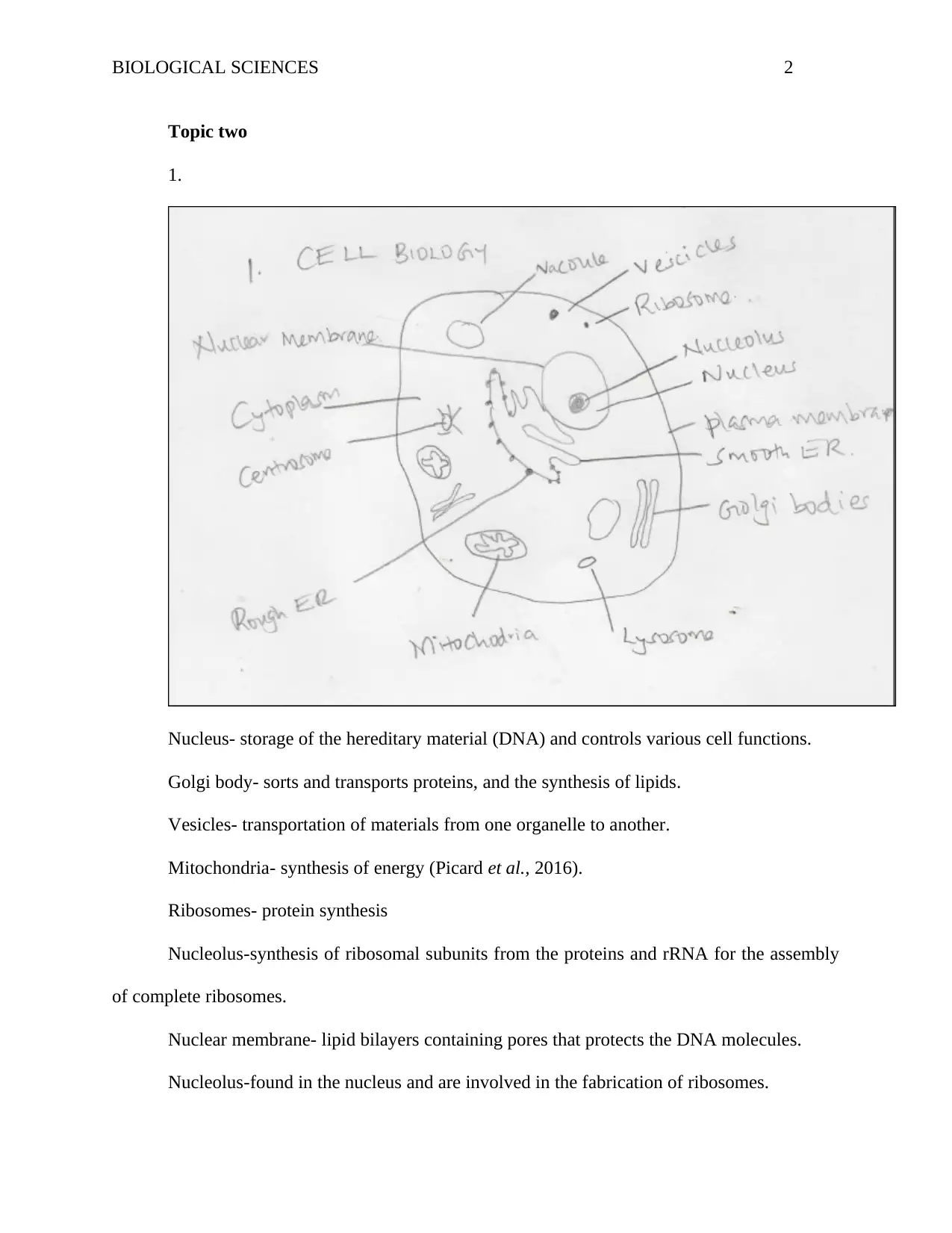
BIOLOGICAL SCIENCES 2
Topic two
1.
Nucleus- storage of the hereditary material (DNA) and controls various cell functions.
Golgi body- sorts and transports proteins, and the synthesis of lipids.
Vesicles- transportation of materials from one organelle to another.
Mitochondria- synthesis of energy (Picard et al., 2016).
Ribosomes- protein synthesis
Nucleolus-synthesis of ribosomal subunits from the proteins and rRNA for the assembly
of complete ribosomes.
Nuclear membrane- lipid bilayers containing pores that protects the DNA molecules.
Nucleolus-found in the nucleus and are involved in the fabrication of ribosomes.
Topic two
1.
Nucleus- storage of the hereditary material (DNA) and controls various cell functions.
Golgi body- sorts and transports proteins, and the synthesis of lipids.
Vesicles- transportation of materials from one organelle to another.
Mitochondria- synthesis of energy (Picard et al., 2016).
Ribosomes- protein synthesis
Nucleolus-synthesis of ribosomal subunits from the proteins and rRNA for the assembly
of complete ribosomes.
Nuclear membrane- lipid bilayers containing pores that protects the DNA molecules.
Nucleolus-found in the nucleus and are involved in the fabrication of ribosomes.
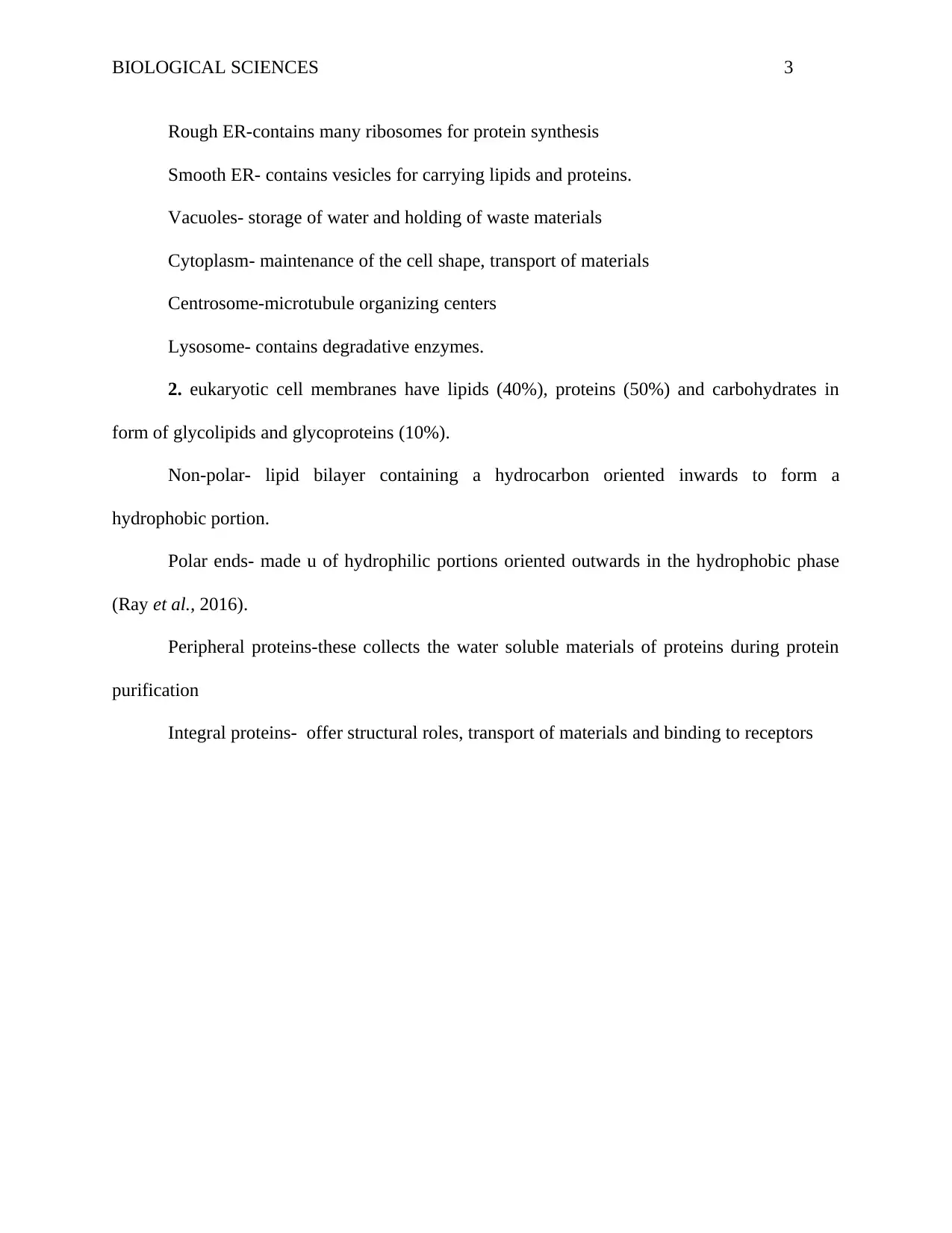
BIOLOGICAL SCIENCES 3
Rough ER-contains many ribosomes for protein synthesis
Smooth ER- contains vesicles for carrying lipids and proteins.
Vacuoles- storage of water and holding of waste materials
Cytoplasm- maintenance of the cell shape, transport of materials
Centrosome-microtubule organizing centers
Lysosome- contains degradative enzymes.
2. eukaryotic cell membranes have lipids (40%), proteins (50%) and carbohydrates in
form of glycolipids and glycoproteins (10%).
Non-polar- lipid bilayer containing a hydrocarbon oriented inwards to form a
hydrophobic portion.
Polar ends- made u of hydrophilic portions oriented outwards in the hydrophobic phase
(Ray et al., 2016).
Peripheral proteins-these collects the water soluble materials of proteins during protein
purification
Integral proteins- offer structural roles, transport of materials and binding to receptors
Rough ER-contains many ribosomes for protein synthesis
Smooth ER- contains vesicles for carrying lipids and proteins.
Vacuoles- storage of water and holding of waste materials
Cytoplasm- maintenance of the cell shape, transport of materials
Centrosome-microtubule organizing centers
Lysosome- contains degradative enzymes.
2. eukaryotic cell membranes have lipids (40%), proteins (50%) and carbohydrates in
form of glycolipids and glycoproteins (10%).
Non-polar- lipid bilayer containing a hydrocarbon oriented inwards to form a
hydrophobic portion.
Polar ends- made u of hydrophilic portions oriented outwards in the hydrophobic phase
(Ray et al., 2016).
Peripheral proteins-these collects the water soluble materials of proteins during protein
purification
Integral proteins- offer structural roles, transport of materials and binding to receptors
⊘ This is a preview!⊘
Do you want full access?
Subscribe today to unlock all pages.

Trusted by 1+ million students worldwide
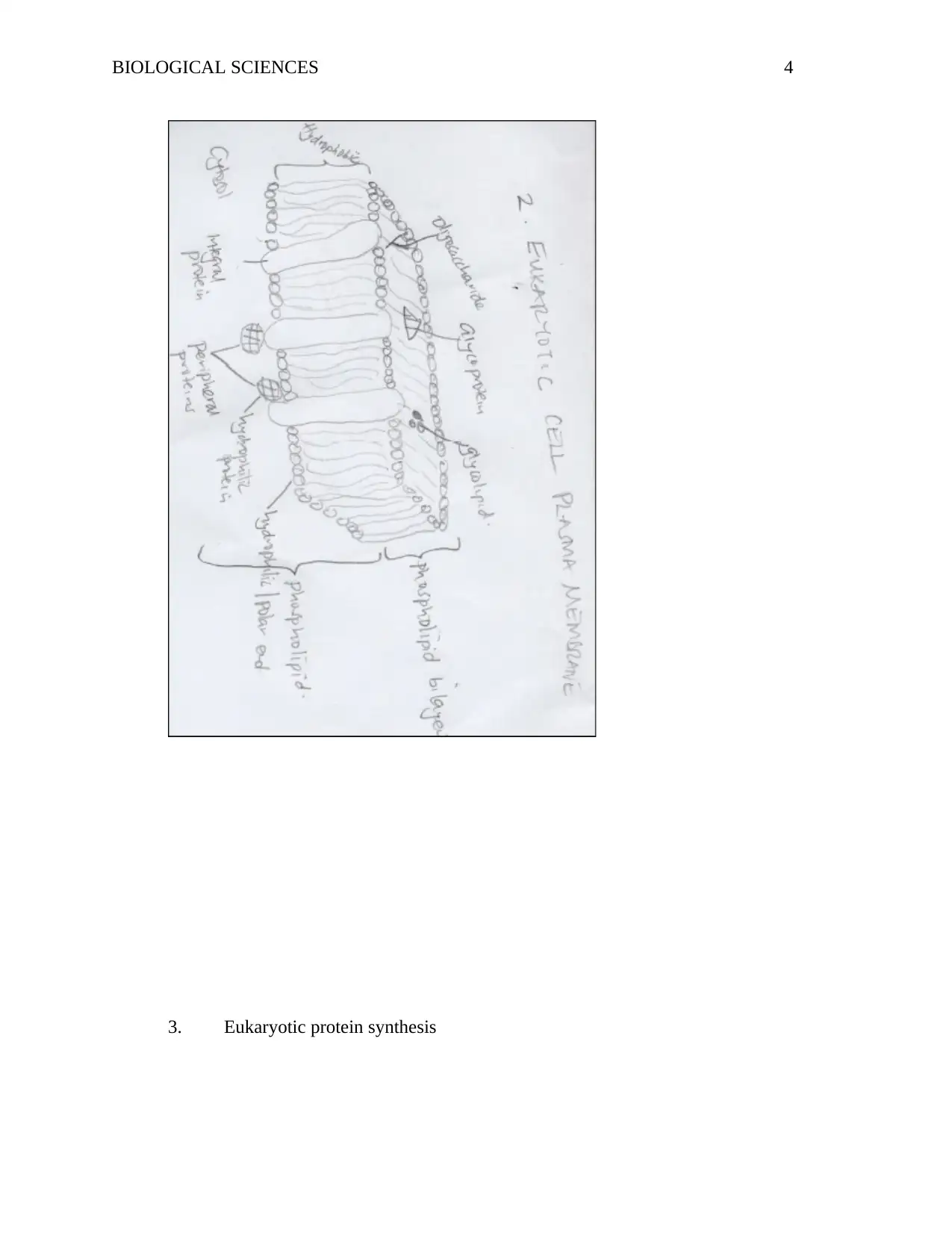
BIOLOGICAL SCIENCES 4
3. Eukaryotic protein synthesis
3. Eukaryotic protein synthesis
Paraphrase This Document
Need a fresh take? Get an instant paraphrase of this document with our AI Paraphraser
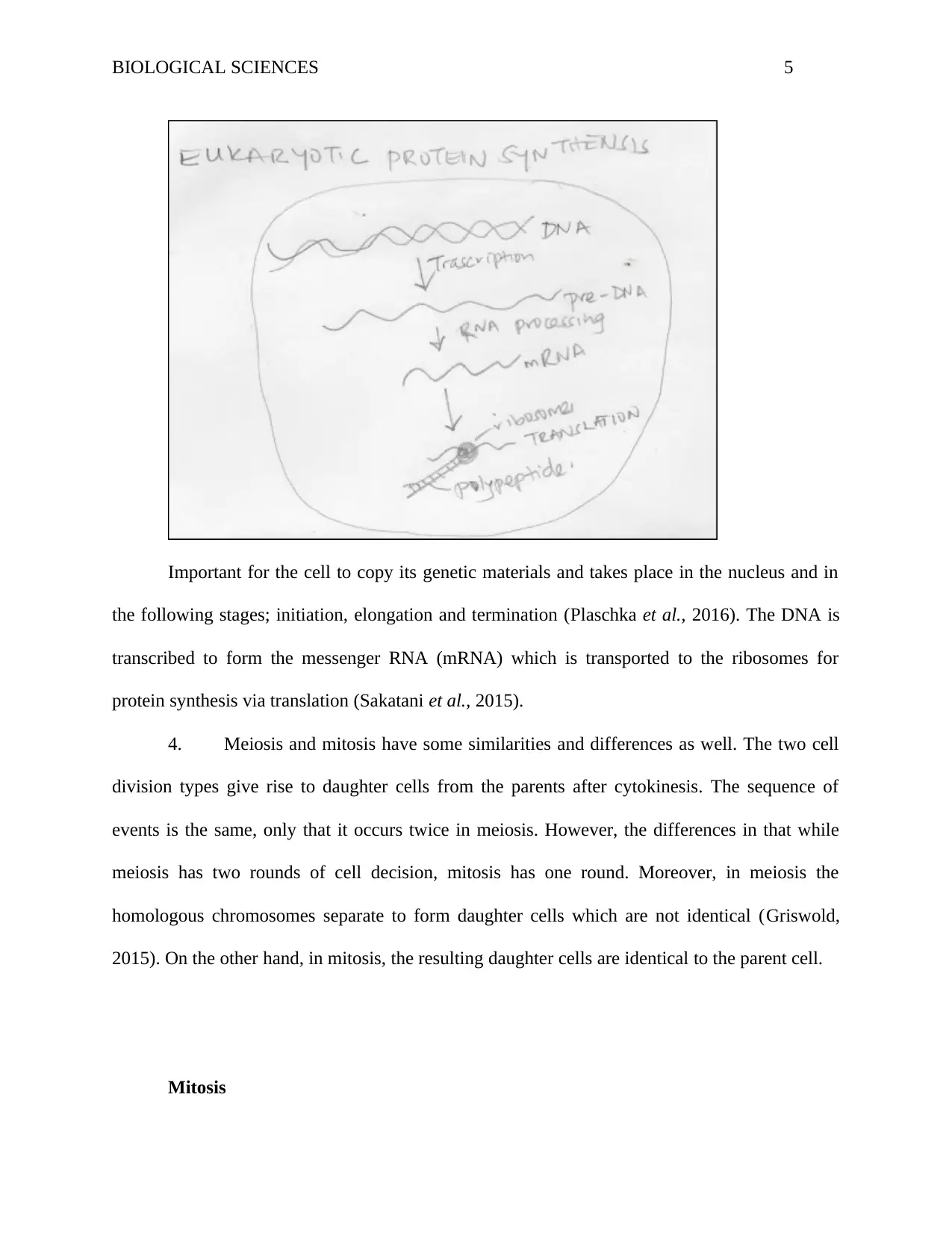
BIOLOGICAL SCIENCES 5
Important for the cell to copy its genetic materials and takes place in the nucleus and in
the following stages; initiation, elongation and termination (Plaschka et al., 2016). The DNA is
transcribed to form the messenger RNA (mRNA) which is transported to the ribosomes for
protein synthesis via translation (Sakatani et al., 2015).
4. Meiosis and mitosis have some similarities and differences as well. The two cell
division types give rise to daughter cells from the parents after cytokinesis. The sequence of
events is the same, only that it occurs twice in meiosis. However, the differences in that while
meiosis has two rounds of cell decision, mitosis has one round. Moreover, in meiosis the
homologous chromosomes separate to form daughter cells which are not identical (Griswold,
2015). On the other hand, in mitosis, the resulting daughter cells are identical to the parent cell.
Mitosis
Important for the cell to copy its genetic materials and takes place in the nucleus and in
the following stages; initiation, elongation and termination (Plaschka et al., 2016). The DNA is
transcribed to form the messenger RNA (mRNA) which is transported to the ribosomes for
protein synthesis via translation (Sakatani et al., 2015).
4. Meiosis and mitosis have some similarities and differences as well. The two cell
division types give rise to daughter cells from the parents after cytokinesis. The sequence of
events is the same, only that it occurs twice in meiosis. However, the differences in that while
meiosis has two rounds of cell decision, mitosis has one round. Moreover, in meiosis the
homologous chromosomes separate to form daughter cells which are not identical (Griswold,
2015). On the other hand, in mitosis, the resulting daughter cells are identical to the parent cell.
Mitosis
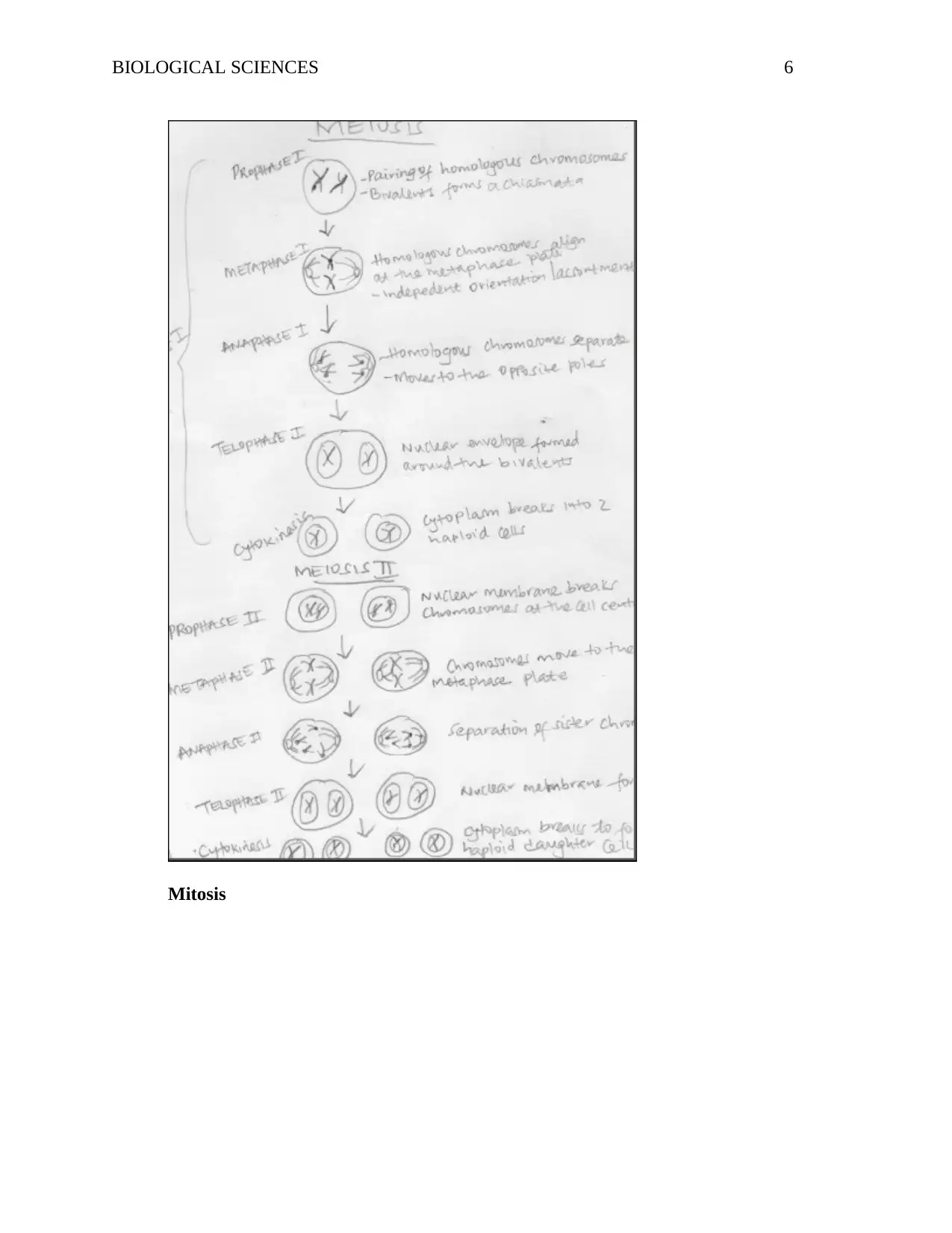
BIOLOGICAL SCIENCES 6
Mitosis
Mitosis
⊘ This is a preview!⊘
Do you want full access?
Subscribe today to unlock all pages.

Trusted by 1+ million students worldwide
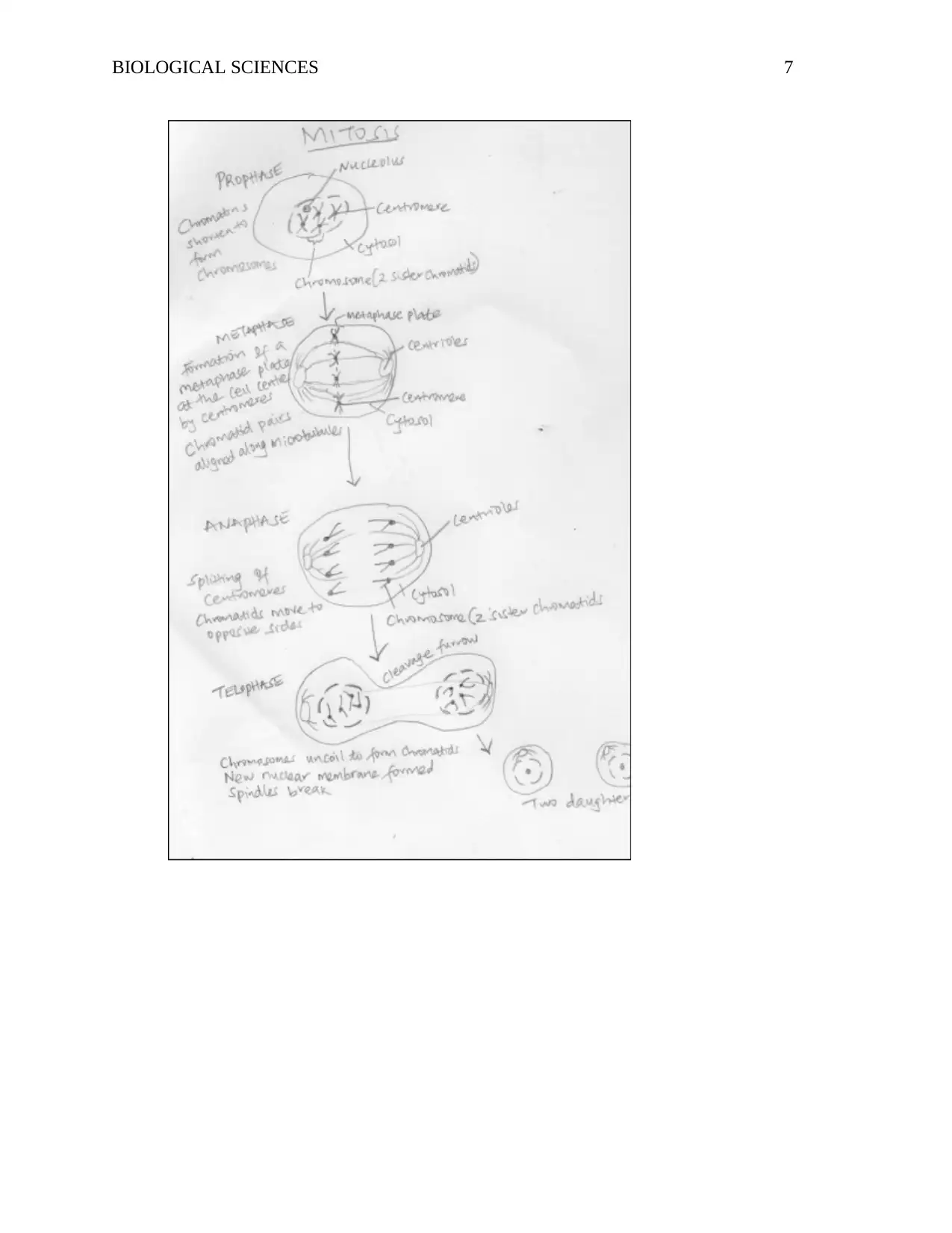
BIOLOGICAL SCIENCES 7
Paraphrase This Document
Need a fresh take? Get an instant paraphrase of this document with our AI Paraphraser
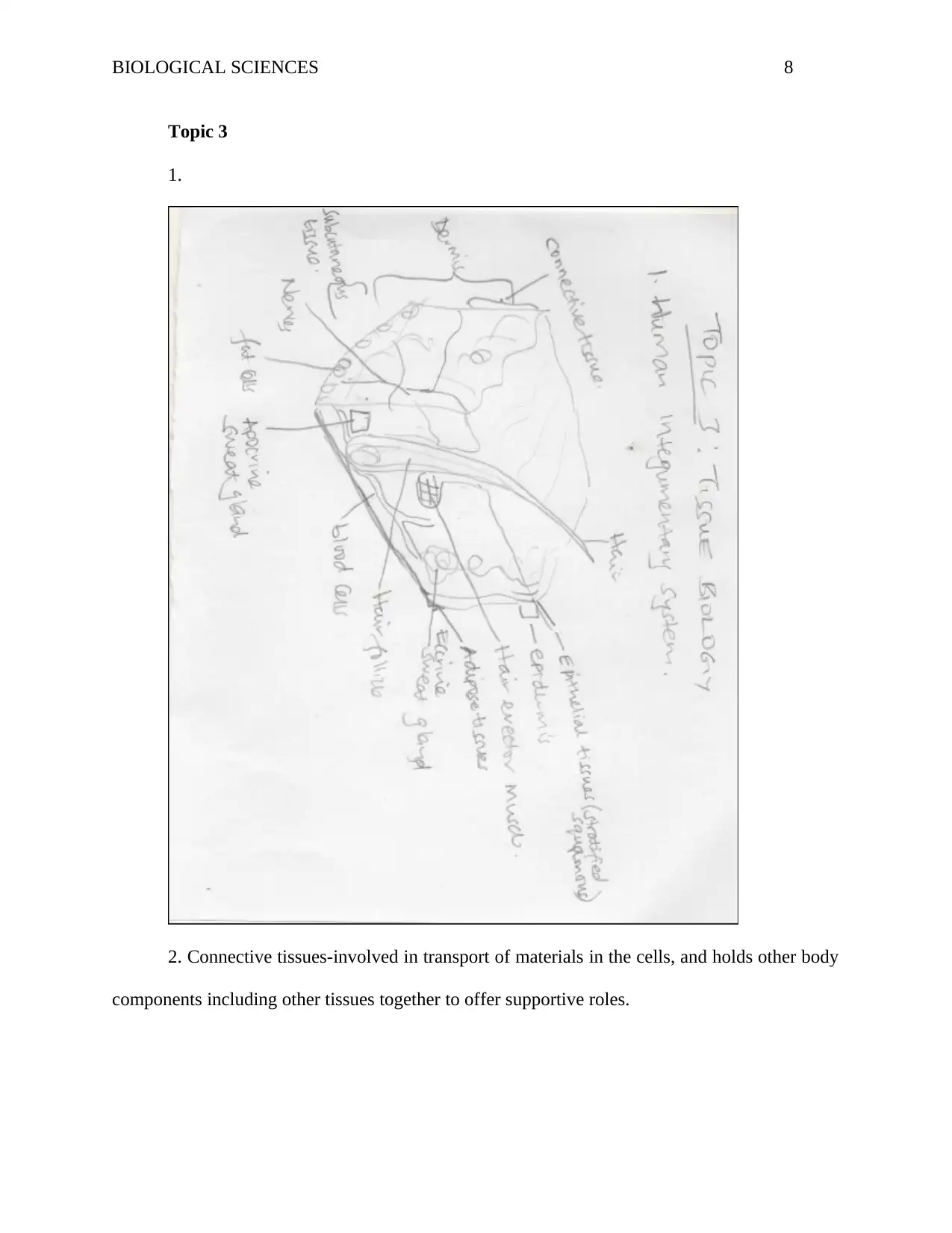
BIOLOGICAL SCIENCES 8
Topic 3
1.
2. Connective tissues-involved in transport of materials in the cells, and holds other body
components including other tissues together to offer supportive roles.
Topic 3
1.
2. Connective tissues-involved in transport of materials in the cells, and holds other body
components including other tissues together to offer supportive roles.
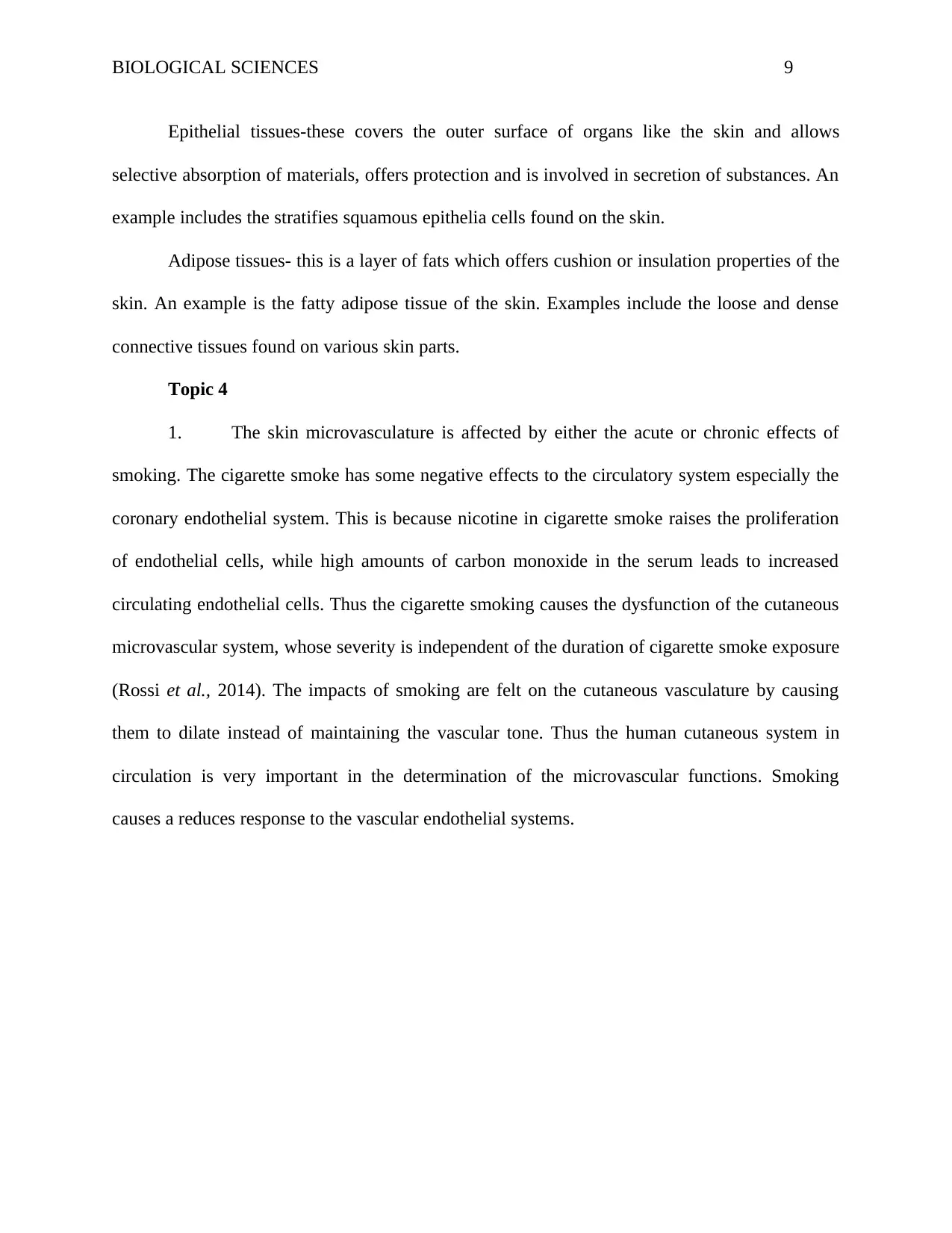
BIOLOGICAL SCIENCES 9
Epithelial tissues-these covers the outer surface of organs like the skin and allows
selective absorption of materials, offers protection and is involved in secretion of substances. An
example includes the stratifies squamous epithelia cells found on the skin.
Adipose tissues- this is a layer of fats which offers cushion or insulation properties of the
skin. An example is the fatty adipose tissue of the skin. Examples include the loose and dense
connective tissues found on various skin parts.
Topic 4
1. The skin microvasculature is affected by either the acute or chronic effects of
smoking. The cigarette smoke has some negative effects to the circulatory system especially the
coronary endothelial system. This is because nicotine in cigarette smoke raises the proliferation
of endothelial cells, while high amounts of carbon monoxide in the serum leads to increased
circulating endothelial cells. Thus the cigarette smoking causes the dysfunction of the cutaneous
microvascular system, whose severity is independent of the duration of cigarette smoke exposure
(Rossi et al., 2014). The impacts of smoking are felt on the cutaneous vasculature by causing
them to dilate instead of maintaining the vascular tone. Thus the human cutaneous system in
circulation is very important in the determination of the microvascular functions. Smoking
causes a reduces response to the vascular endothelial systems.
Epithelial tissues-these covers the outer surface of organs like the skin and allows
selective absorption of materials, offers protection and is involved in secretion of substances. An
example includes the stratifies squamous epithelia cells found on the skin.
Adipose tissues- this is a layer of fats which offers cushion or insulation properties of the
skin. An example is the fatty adipose tissue of the skin. Examples include the loose and dense
connective tissues found on various skin parts.
Topic 4
1. The skin microvasculature is affected by either the acute or chronic effects of
smoking. The cigarette smoke has some negative effects to the circulatory system especially the
coronary endothelial system. This is because nicotine in cigarette smoke raises the proliferation
of endothelial cells, while high amounts of carbon monoxide in the serum leads to increased
circulating endothelial cells. Thus the cigarette smoking causes the dysfunction of the cutaneous
microvascular system, whose severity is independent of the duration of cigarette smoke exposure
(Rossi et al., 2014). The impacts of smoking are felt on the cutaneous vasculature by causing
them to dilate instead of maintaining the vascular tone. Thus the human cutaneous system in
circulation is very important in the determination of the microvascular functions. Smoking
causes a reduces response to the vascular endothelial systems.
⊘ This is a preview!⊘
Do you want full access?
Subscribe today to unlock all pages.

Trusted by 1+ million students worldwide
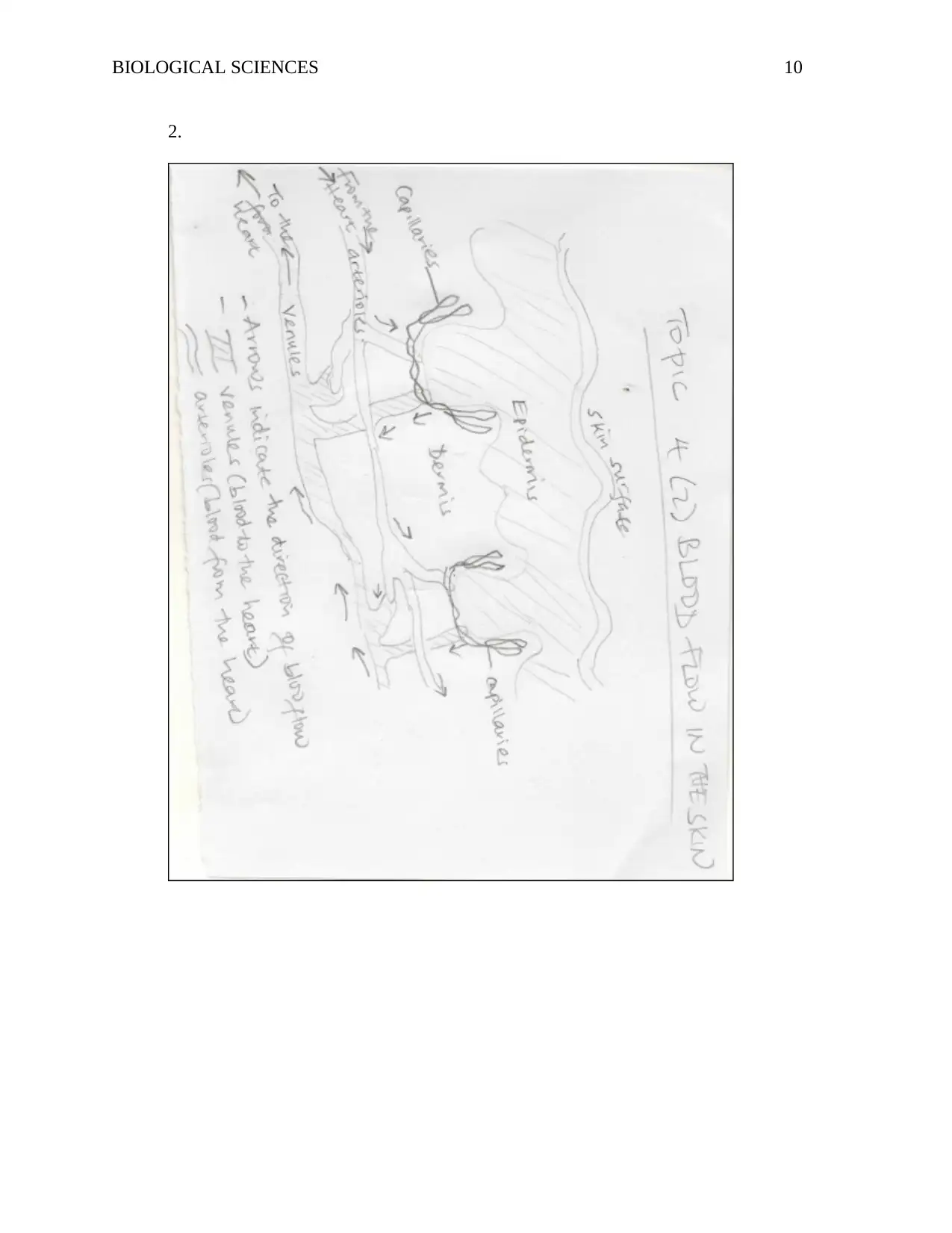
BIOLOGICAL SCIENCES 10
2.
2.
Paraphrase This Document
Need a fresh take? Get an instant paraphrase of this document with our AI Paraphraser
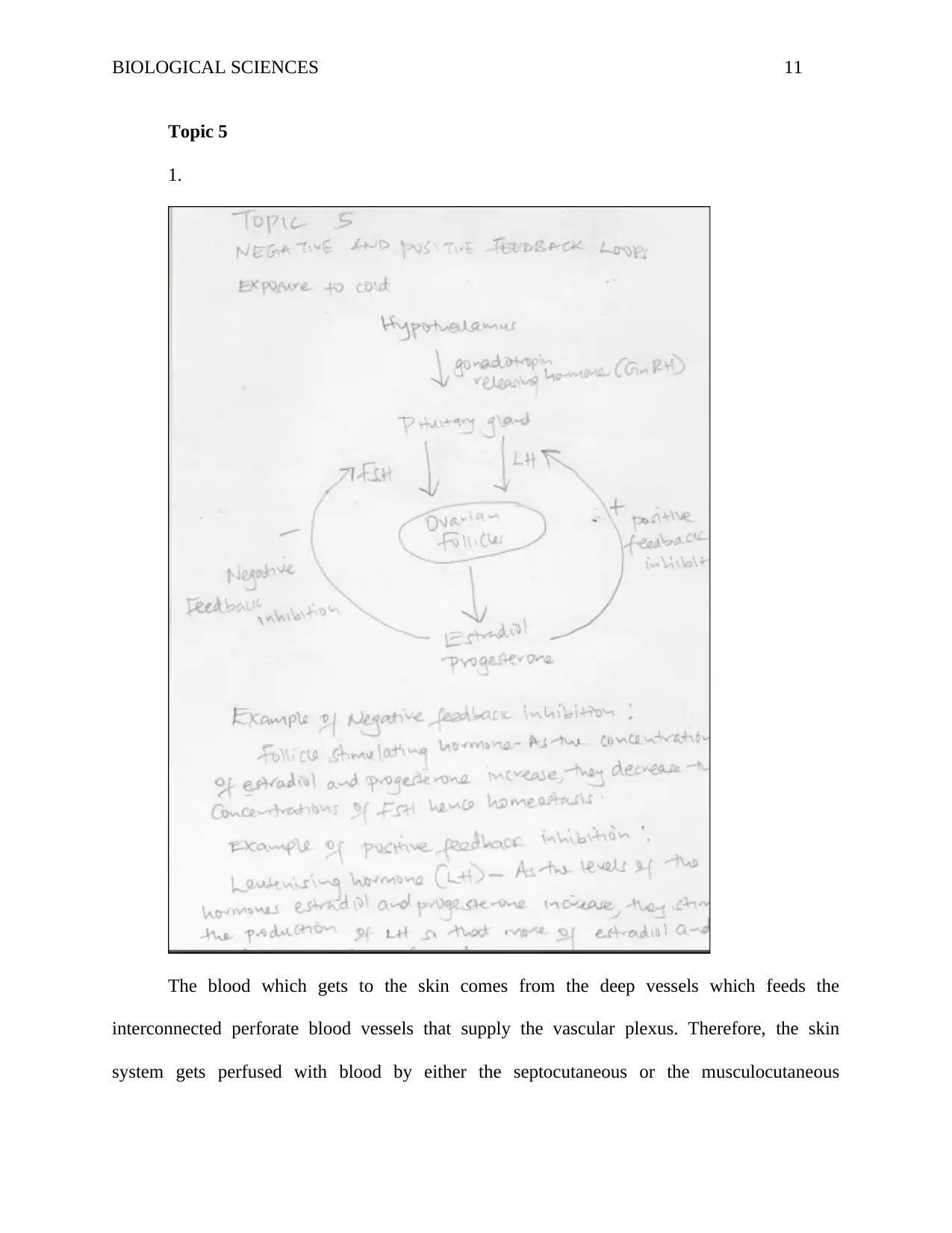
BIOLOGICAL SCIENCES 11
Topic 5
1.
The blood which gets to the skin comes from the deep vessels which feeds the
interconnected perforate blood vessels that supply the vascular plexus. Therefore, the skin
system gets perfused with blood by either the septocutaneous or the musculocutaneous
Topic 5
1.
The blood which gets to the skin comes from the deep vessels which feeds the
interconnected perforate blood vessels that supply the vascular plexus. Therefore, the skin
system gets perfused with blood by either the septocutaneous or the musculocutaneous
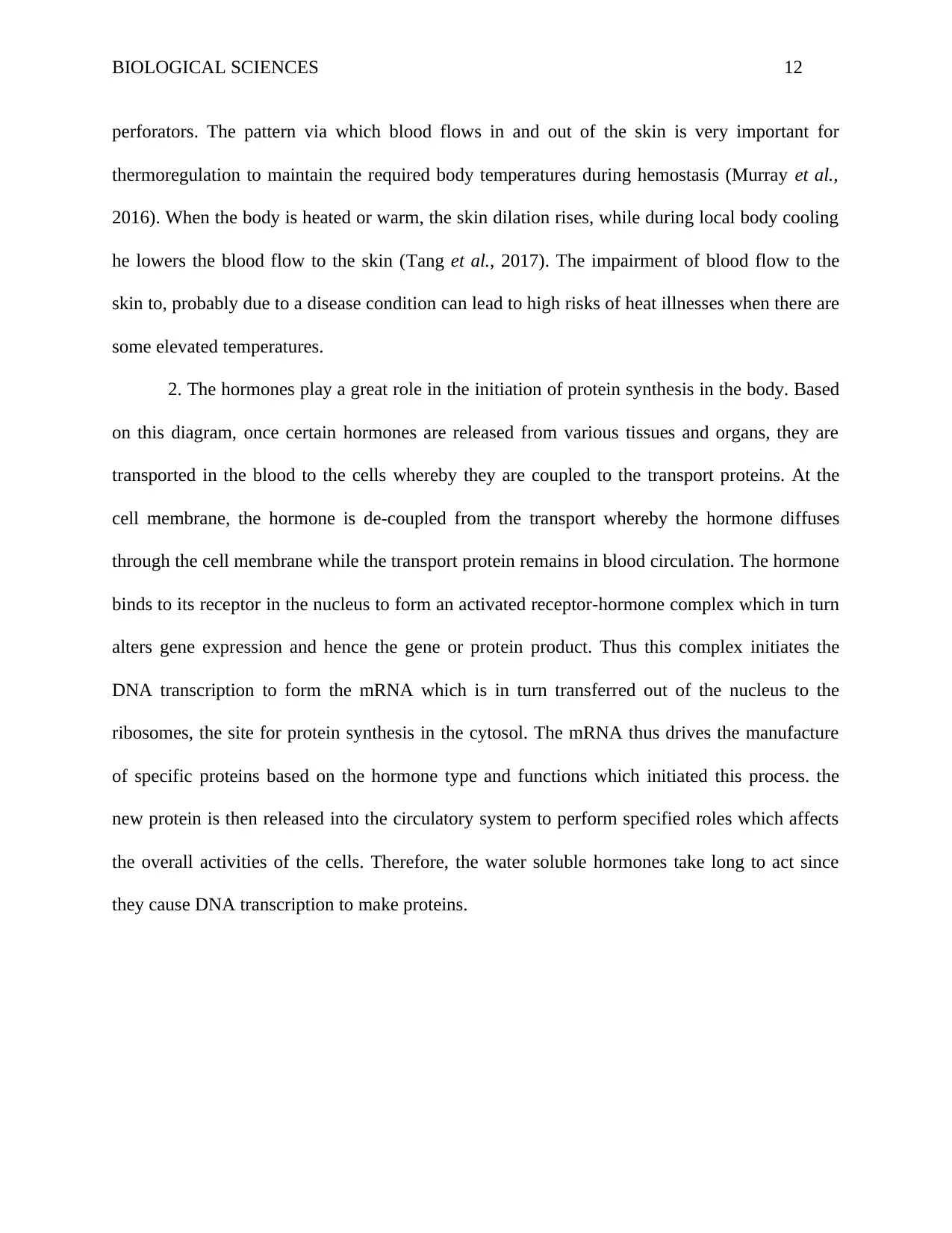
BIOLOGICAL SCIENCES 12
perforators. The pattern via which blood flows in and out of the skin is very important for
thermoregulation to maintain the required body temperatures during hemostasis (Murray et al.,
2016). When the body is heated or warm, the skin dilation rises, while during local body cooling
he lowers the blood flow to the skin (Tang et al., 2017). The impairment of blood flow to the
skin to, probably due to a disease condition can lead to high risks of heat illnesses when there are
some elevated temperatures.
2. The hormones play a great role in the initiation of protein synthesis in the body. Based
on this diagram, once certain hormones are released from various tissues and organs, they are
transported in the blood to the cells whereby they are coupled to the transport proteins. At the
cell membrane, the hormone is de-coupled from the transport whereby the hormone diffuses
through the cell membrane while the transport protein remains in blood circulation. The hormone
binds to its receptor in the nucleus to form an activated receptor-hormone complex which in turn
alters gene expression and hence the gene or protein product. Thus this complex initiates the
DNA transcription to form the mRNA which is in turn transferred out of the nucleus to the
ribosomes, the site for protein synthesis in the cytosol. The mRNA thus drives the manufacture
of specific proteins based on the hormone type and functions which initiated this process. the
new protein is then released into the circulatory system to perform specified roles which affects
the overall activities of the cells. Therefore, the water soluble hormones take long to act since
they cause DNA transcription to make proteins.
perforators. The pattern via which blood flows in and out of the skin is very important for
thermoregulation to maintain the required body temperatures during hemostasis (Murray et al.,
2016). When the body is heated or warm, the skin dilation rises, while during local body cooling
he lowers the blood flow to the skin (Tang et al., 2017). The impairment of blood flow to the
skin to, probably due to a disease condition can lead to high risks of heat illnesses when there are
some elevated temperatures.
2. The hormones play a great role in the initiation of protein synthesis in the body. Based
on this diagram, once certain hormones are released from various tissues and organs, they are
transported in the blood to the cells whereby they are coupled to the transport proteins. At the
cell membrane, the hormone is de-coupled from the transport whereby the hormone diffuses
through the cell membrane while the transport protein remains in blood circulation. The hormone
binds to its receptor in the nucleus to form an activated receptor-hormone complex which in turn
alters gene expression and hence the gene or protein product. Thus this complex initiates the
DNA transcription to form the mRNA which is in turn transferred out of the nucleus to the
ribosomes, the site for protein synthesis in the cytosol. The mRNA thus drives the manufacture
of specific proteins based on the hormone type and functions which initiated this process. the
new protein is then released into the circulatory system to perform specified roles which affects
the overall activities of the cells. Therefore, the water soluble hormones take long to act since
they cause DNA transcription to make proteins.
⊘ This is a preview!⊘
Do you want full access?
Subscribe today to unlock all pages.

Trusted by 1+ million students worldwide
1 out of 16
Related Documents
Your All-in-One AI-Powered Toolkit for Academic Success.
+13062052269
info@desklib.com
Available 24*7 on WhatsApp / Email
![[object Object]](/_next/static/media/star-bottom.7253800d.svg)
Unlock your academic potential
Copyright © 2020–2025 A2Z Services. All Rights Reserved. Developed and managed by ZUCOL.





